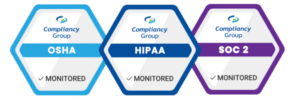What is OSHA 10 Healthcare?
When an employer asks a job applicant to show his or her “OSHA card,” the employer is asking for an OSHA student course completion card. The completed course is the OSHA Outreach Training Program’s 10-hour safety course. Individuals are eligible to enroll in this online course regardless of their occupation. OSHA offers the 10-hour course both for general industry and construction. The 10-hour general industry course is intended for entry-level workers. This OSHA 10 healthcare course provides information about worker rights, employer responsibilities, and how to file a complaint. You might be wondering, what is this OSHA 10 healthcare course about? The general industry course, referred to as the “OSHA 10” course, also provides basic awareness training on the recognition, avoidance, abatement, and prevention of workplace hazards. The general industry course, as its name implies, is not specific to any industry. As such, there is no such thing as an OSHA 10 healthcare course. The OSHA 10 general industry course does, however, address topics that are of importance to healthcare workplace safety. OSHA 10 healthcare instruction is discussed below.
OSHA 10 Healthcare: What Topics Do Healthcare Employees Need to Know About?
The general industry course provides basic awareness training on the recognition, avoidance, abatement, and prevention of workplace hazards. OSHA 10 healthcare training provided by the course is in the form of training on the concepts of avoidance, abatement, and prevention of workplace hazard. These concepts are tied to another concept, the “hierarchy of controls.”
The OSHA hierarchy of controls can be visualized as a pyramid. The pyramid has five blocks, each representing a type of hazard control. The block at the top represents the most effective workplace control. As one goes down the pyramid to the base, each block represents a progressively less effective control.
The five blocks, from top to bottom, are:
◈ Elimination (physical removal of a hazard)
◈ Substitution (replacing a hazard with something less hazardous)
◈ Engineering Controls (isolating people from the hazard)
◈ Administrative Controls (changing the way people work)
◈ Personal Protective Equipment (clothing and equipment that reduce hazard exposure)
The blocks in the hierarchy are discussed in greater detail below.
OSHA 10 Healthcare: Elimination and Substitution
Elimination of a hazard is its removal from a workplace. An example of elimination is removal of asbestos from a building. Substitution is the replacing of a hazard by something that is more safe. An example of substitution is transitioning to a safer chemical.
Elimination and substitution are the most effective hazard controls. If the process is still at the design or development stage, elimination and substitution of hazards may be inexpensive and relatively simple to implement. For an existing process, however, major changes in equipment and procedures may be required to eliminate or substitute for a hazard.
OSHA Healthcare 10: Engineering Controls
Engineering controls are physical changes to the workplace, which eliminate or reduce the hazard. Engineering controls include changing processes to minimize contact with hazardous chemicals, such as by isolating or enclosing these processes. Engineering controls are favored over administrative and personal protective equipment (PPE) for controlling existing worker exposures in the workplace, because they are designed to remove the hazard at the source, before it actually comes into contact with an employee.
OSHA Healthcare 10: Administrative Controls and PPE
Administrative controls are work practice controls – changes in the way a task is performed. Healthcare examples include prohibiting recapping of needles, as well as rotating worker shifts. Personal protective equipment, the least effective control, is clothing and equipment (i.e., masks, gowns, safety helmets) provided by an employer to an employee to mitigate hazard exposure.
Administrative controls and PPE are frequently used with existing processes where hazards are not particularly well controlled. Administrative controls and PPE programs may be relatively inexpensive to establish but, over the long term, can be very costly to sustain. These methods for protecting workers have also proven to be less effective than other measures, and are regarded by OSHA as “last resort” measures.






